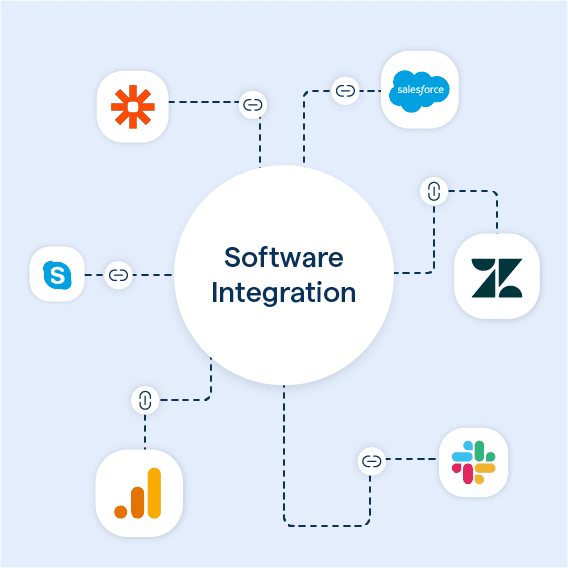What is Software Integration?
Software integration is the process of combining different software applications or components to work together as a unified system.
This integration allows these individual software elements to communicate, share data, and function as a cohesive unit, even though they may have been developed independently or by different vendors.
Why does Software Integration Matter?
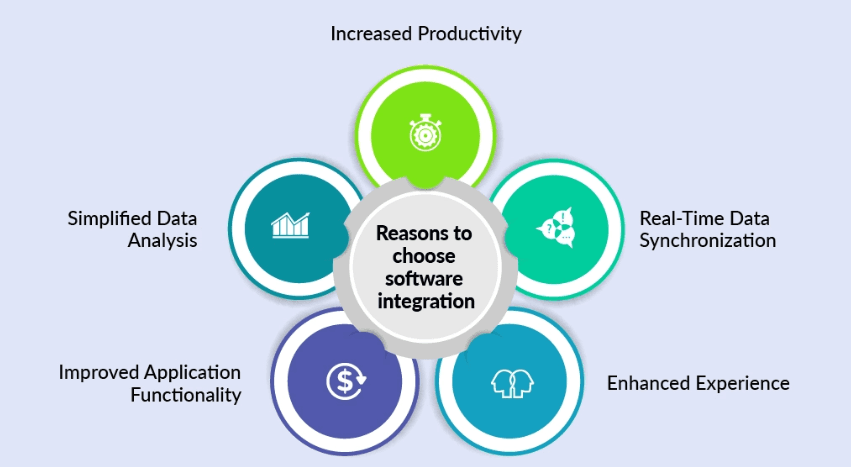
- Enhancing Efficiency: Software integration plays a crucial role in enhancing efficiency by allowing different software systems to seamlessly work together.
It eliminates the need for manual data transfer and reduces repetitive tasks, saving valuable time and effort.
- Improving Workflow: By integrating various software applications, organizations can streamline their workflow. This leads to improved collaboration, information sharing, and process automation, resulting in a more efficient and productive work environment.
- Streamlining Communication: Software integration enables seamless communication between different systems, departments, and stakeholders.
It ensures that data flows seamlessly, avoiding any communication gaps or inconsistencies that can hinder productivity and decision-making.
- Increasing Productivity: Integrating software solutions eliminates duplication of efforts, reduces manual errors, and improves data accuracy.
This results in increased productivity as employees can focus on value-added tasks rather than wasting time on repetitive and manual data handling.
- Optimizing Resource Utilization: Efficient software integration enables organizations to optimize resource utilization.
By sharing data and resources across systems, organizations can eliminate redundancy and make the most out of their investments in software and infrastructure.
Types of Software Integration
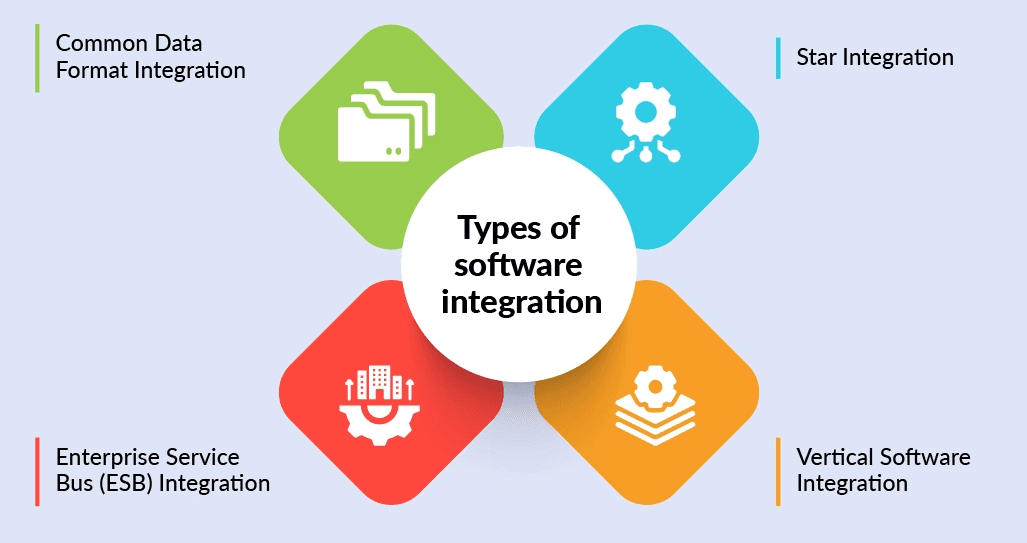
Point-To-Point Integration
Point-to-point integration connects two applications directly to each other. While this approach is simple and straightforward, it can become complex and difficult to manage as the number of applications increases.
Vertical Integration
Vertical integration involves integrating applications in a sequential or hierarchical manner based on specific business processes or workflows.
This method reduces complexity but can be rigid and lacks flexibility.
Star Integration

In Star integration, a central system serves as an integration hub, and all other systems connect to this hub.
While this simplifies the integration process, any changes in the hub system can impact all connected systems.
Horizontal Integration
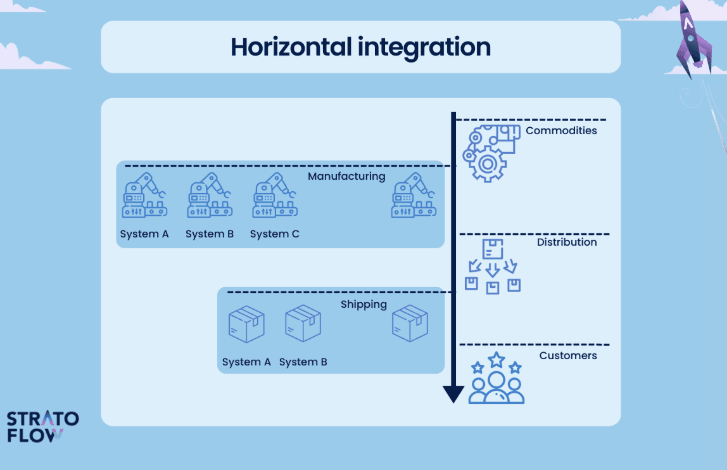
Horizontal integration, also known as Enterprise Service Bus (ESB), uses a central system to communicate between systems.
ESB manages message routing, choreography, transformation, and other integration functions, offering a flexible, scalable, and robust solution.
Hybrid Integration
Hybrid integration combines different integration methods. It's becoming increasingly popular as companies move towards adopting a mix of on-premise, cloud and SaaS based applications. This approach offers greater flexibility and scalability, accommodating a wide variety of scenarios.
Who Benefits from Software Integration?
- Organizations: Organizations of all sizes and industries can benefit from software integration. It allows them to optimize business processes, improve collaboration, enhance customer experiences, and gain a competitive edge in the market.
- IT Teams: Software integration empowers IT teams to streamline system management, reduce complexity, and enhance security.
It enables them to manage integrations, monitor performance, and ensure data integrity across the organization.
- Developers: Developers benefit from software integration by leveraging existing software systems and APIs to build innovative solutions faster.
Integration simplifies the development process, reduces coding efforts, and makes it easier to create complex applications.
- End Users: End users, such as employees, customers, and partners, enjoy a seamless experience when software systems are integrated.
They benefit from faster access to information, improved usability, and consistent user interfaces across various applications.
How Does Software Integration Work?

Designing an Integration Strategy
Before implementing software integration, it is essential to design a comprehensive integration strategy.
This involves identifying integration requirements, defining the scope, and planning the approach and timeline for integration projects.
Choosing Integration Tools
Selecting the right integration tools is crucial for successful implementation. Various tools, such as middleware, integration platforms, and APIs, are available to facilitate integration.
It is important to choose tools that align with business needs, scalability requirements, and budget constraints.
Data Integration Techniques
- Extract, Transform, Load (ETL): ETL is a data integration technique that involves extracting data from source systems, transforming it into a compatible format, and then loading it into the target system. It is commonly used for batch processing and data migration projects.
- Application Programming Interfaces (APIs): APIs allow different software systems to communicate and share data in a standardized and secure manner.
They provide a set of rules and protocols for integrating systems, enabling seamless data exchange and functionality sharing.
- Message Queuing: Message queuing involves sending messages between software systems through a queuing system. It ensures reliable and asynchronous communication, allowing systems to process messages at their own pace, ensuring data integrity and system availability.
When to Consider Software Integration?
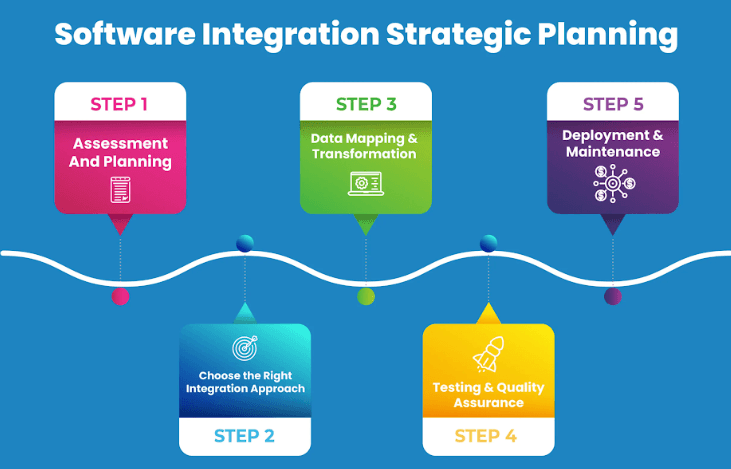
Migrating to a New System
When migrating to a new software system, integration becomes crucial for ensuring a smooth transition of data and functionalities from the old system to the new one.
Integration helps in minimizing disruptions and data loss during the migration process.
Automating Business Processes
Automation of business processes can be achieved through software integration.
By integrating systems, organizations can automate data transfer, notifications, approvals, and other manual tasks, leading to increased efficiency and accuracy in business operations.
Scaling Operations
As organizations grow and expand, software integration becomes vital for scaling operations.
Integrating systems allows organizations to handle increased data volume, accommodate new processes, and support a growing number of users without compromising performance.
Improving Data Accuracy
Software integration helps organizations in ensuring data accuracy by eliminating manual data entry errors, duplication, and inconsistency.
Integrating systems enables real-time data synchronization, making sure that the most up-to-date and accurate data is available across all applications.
Challenges in Software Integration
- Compatibility Issues: One of the major challenges in software integration is ensuring compatibility between different systems.
Integrating systems using different technologies, data formats, and protocols can be complex and require specialized skills and tools.
- Data Silos: Data silos are isolated repositories of data that are not easily accessible or shareable with other systems. Integrating systems with data silos requires careful planning and mapping of data structures to ensure seamless data flow and accessibility across applications.
- Security Risks: Integrating different systems can expose organizations to security risks. It is important to implement robust security measures, such as encryption, secure authentication, and access controls, to safeguard data and prevent unauthorized access or breaches.
- Implementation Complexities: Software integration projects can be complex and time-consuming. They often involve multiple stakeholders, coordination between various teams, and the potential need for customization or development work.
Effective project planning, resource allocation, and project management are essential to overcome these complexities.
Best Practices for Software Integration

Planning and Documentation
Thorough planning and documentation are essential for successful software integration.
It involves understanding integration requirements, documenting integration processes, data flows, and system dependencies, and maintaining up-to-date documentation throughout the integration project.
Prioritizing Standardization
Standardization plays a crucial role in software integration.
By using industry-standard data formats, protocols, and integration patterns, organizations can ensure compatibility, simplify integration efforts, and reduce maintenance and troubleshooting challenges.
Testing and Quality Assurance
Comprehensive testing and quality assurance are critical for ensuring the reliability and performance of integrated systems.
Rigorous testing, including functional testing, performance testing, and data integrity validation, helps in identifying and addressing potential issues before deploying the integrated solution.
Regular System Maintenance
Regular system maintenance is vital for the smooth functioning of integrated systems.
This includes monitoring system performance, addressing any integration errors or issues, updating software and security patches, and ensuring data backups and disaster recovery plans are in place.
Tl;DR
Software integration is a crucial aspect of modern business operations. It enables organizations to enhance efficiency, improve workflow, streamline communication, increase productivity, and optimize resource utilization.
By understanding the definition, types, benefits, challenges, and best practices of software integration, you can unlock the full potential of your software ecosystem and drive business growth.
Frequently Asked Questions (FAQs)
What is software integration?
Software integration refers to the process of combining different software applications or systems to work together seamlessly, so they can share data and communicate effectively.
Why is software integration important?
Software integration is important because it allows different systems to work together, eliminating manual data entry and improving efficiency.
It helps businesses streamline processes and make better-informed decisions.
How can software integration benefit my business?
Software integration can benefit your business by automating tasks, reducing errors, and improving collaboration. It enables real-time data sharing between systems, leading to better insights and more informed decision-making.
Are there any challenges with software integration?
Yes, software integration can present challenges such as compatibility issues, data mapping complexities, and the need for proper planning and testing.
However, with careful implementation and support, these challenges can be overcome.
How can I ensure successful software integration?
To ensure successful software integration, it is important to define clear goals, choose compatible systems, involve stakeholders early on, perform thorough testing, and seek professional assistance if needed. Regular monitoring and updates are also crucial.
